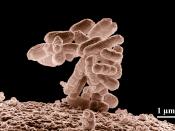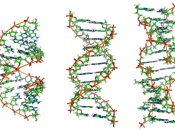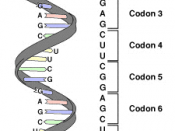The genetic material of most viruses and all cellular organisms, humans included, consists of one or more molecules of deoxyribonucleic acid, better known as DNA. In the nucleus of each human cell, there are 46 chromosomes, and each chromosome contains a single DNA molecule. For comparison, in the bacterial species Escherichia coli, each cell has only one chromosome and thus only one DNA molecule.
Regardless of the organism, every molecule of DNA is constructed of two parallel, ribbons like chains that form a coil, or double helix. Each chain is composed of a series of linked units called nucleotides. There are 3 billion nucleotides in each human cell, while each E. coli cell has 4.7 million nucleotides. Each nucleotide consists of three subunits: a sugar called deoxyribose, a phosphate group attached to one end of the sugar, and, most important, a base, the subunit that determines the genetic characteristics of an organism, attached to the other end of the sugar.
There are four different bases in DNA: adenine (A), guanine (G), thymine (T), and cytosine (C). It is the difference in number and sequence of these bases that distinguishes the genes of an individual, for example the gene for the enzyme lactase from the gene for hemoglobin. Further, it is the difference in sequence of bases that gives each individual of a species its particular characteristics such as brown eyes or blue eyes, and finally, it is the difference in number and sequence of bases that distinguishes a human from a chimpanzee. The sequence of bases in DNA serves as a genetic code to determine the corresponding sequence of amino acids in each protein of an organism. The actual mechanism of protein synthesis involves the use of intermediary RNA molecules.



Ummm. . . . .
this essay is good for being a refrence to DNA but as for being a full essay highly doubtful a report maybe still kinda vague about certain aspects though
1 out of 1 people found this comment useful.